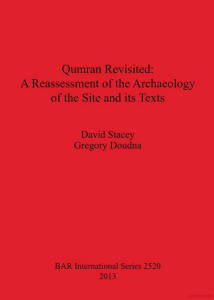 I have frequently heard of doubts that the Qumran (the site of the Dead Sea Scrolls) consisted of Essenes or even of any sectarian community at all, but until today I have not taken time out to read some of the relevant studies. Today I have come across many arguments denying that Qumran was ever a long-term site for a religious community of any kind, and certainly not a monastic-type of sectarian one. Not even Essenes set up base there. So I’ll set out here a subsection of those arguments. I’ve been reading articles, papers and chapters that cried out for my attention directly and indirectly as a result Gregory Doudna’s 2014 conference paper, “Dating the Scroll Deposits of the Qumran Caves: A Question of Evidence” (published 2017 in the conference proceedings, The Caves of Qumran) — see the previous post — and what follows is taken from the chapter by archaeologist David Stacey in Qumran Revisited: A Reassessment of the Archaeology of the Site and its Texts, and that he has helpfully placed online at academia.
I have frequently heard of doubts that the Qumran (the site of the Dead Sea Scrolls) consisted of Essenes or even of any sectarian community at all, but until today I have not taken time out to read some of the relevant studies. Today I have come across many arguments denying that Qumran was ever a long-term site for a religious community of any kind, and certainly not a monastic-type of sectarian one. Not even Essenes set up base there. So I’ll set out here a subsection of those arguments. I’ve been reading articles, papers and chapters that cried out for my attention directly and indirectly as a result Gregory Doudna’s 2014 conference paper, “Dating the Scroll Deposits of the Qumran Caves: A Question of Evidence” (published 2017 in the conference proceedings, The Caves of Qumran) — see the previous post — and what follows is taken from the chapter by archaeologist David Stacey in Qumran Revisited: A Reassessment of the Archaeology of the Site and its Texts, and that he has helpfully placed online at academia.
I set out here Stacey’s argument that is based entirely on the archaeological evidence without any reference to the contents of the scrolls. Of course some may object that this is not fair since the contents of the scrolls are also part of the archaeological finds and they, too, need to be taken into account. So if we read in the scrolls evidence that they were written by a sectarian community, one vehemently opposed to the Jerusalem Temple establishment, for instance, then that information cannot be ignored. Bear with me. By the time we have finished these posts we may be wondering if some of us have rather been reading stories of a sectarian and anti-priesthood community into, not in, the scrolls. One step at a time.
Compare Steve Mason, Josephus, Judea and Christian Origins, p. 240:
Such a circular method — we interpret Josephus’s statements about the Essenes in light of the DSS and then use the alleged parallels to prove the identity of the two groups — could not generate stable results.
David Stacey begins by noting the circularity of the argument that the Qumran site was a base for Essenes.
Concepts found in the sectarian literature of the scrolls, and in references to Essenes by various classical authors, were freely used to interpret aspects of the archaeology of Qumran, and these interpretations then used, in a circular argument, to ‘prove’ that the site was ‘religious in character, with special ritual observances of its own’ (de Vaux 1973: 87). (Stacey, p. 71. My own bolding and formatting in all quotations)
Stacey’s background as an archaeologist is in studying sites nearby Qumran (e.g. Jericho) from the same general period. His conclusion is that the Qumran site was for most of the two centuries either side of the BCE/CE dividing line a seasonally occupied malodorous site producing leather, glue and dyes for wool. It was deserted every summer when it became “unendurably hot” for both humans and flocks.
Not a very romantic picture, is it. Stacey better have some good arguments if we wants to shatter illusions of a scholarly community happily withdrawn from the outside world and dedicated to writing and studying scrolls.
The concept of a community of poor sectarians isolated in the desert and busily writing scrolls has some obvious appeal for scholars labouring in the ivory tower of academe, or for theologians sequestered within their own esoteric communities.
Furthermore it is the romantic, mystical aura that has been generated around Qumran that sells semi-popular books, fills lecture halls, and brings in the tourist, not the unremarkable ruins themselves.
Any indication that the site may have existed solely to play a small part in the local regional economy will be resisted as an altogether too mundane concept. (p. 71)
.
Not so isolated

The isolation of the site has been stressed by those who believe it was occupied by a monastic type of sect. For example on BiblePlaces.com we read:
10 miles south of Jericho, Qumran was on a “dead-end street” and provided a perfect location for the isolationist sect of the Essenes to live.
Stacey suggests that the sense of isolation at the time of the discovery of the scrolls in nearby caves was magnified by the geo-political situation at the time:
The modern geo-political situation at the time of the excavations meant that Qumran was exaggeratedly isolated, being close to a border between hostile modern states. Although the actual border between Jordan and Israel was, until 1967, some kilometres to the south (to the north of Ein Gedi) the ruggedness of the terrain south of Ein Feshka meant that Qumran was very much a border post. When I hitch-hiked to Qumran in 1964 the only vehicles in the vicinity of Qumran were military, the few people one saw were soldiers, and there were signs warning of imminent mine fields further south. Similar warnings could be seen, I later noticed, on the other side of the border, immediately north of Nahal David in Ein Gedi. This apparent isolation at the time of the excavations added artificial weight to the concept of a secluded community that had been gleaned from both the sectarian scrolls and the classical authors. (p. 7)
Stacey discusses in detail the site’s administrative and economic links to Jericho and further, quoting a line from Yizhar Hirschfeld, writes: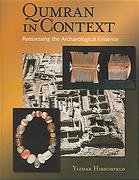
Qumran was only one of several sites along the western littoral of the Dead Sea to be developed during the Hasmonean period, most probably by Jannaeus [103-76 BCE], who, eventually, gained control of land to the north-east of the Dead Sea where he established a fortress at Machaerus, c. 90 BCE (War 7.6.2). Harbour installations were built at Rujm el Bahr and at Qasr el-Yehud/Khirbet Mazin (Bar-Adon 1989) and a large structure at En el-Ghuweir was built (Bar-Adon 1977).37 Further south Ein Gedi continued to be a thriving settlement. Qumran was thus ‘a veritable maelstrom of activity rather than an isolated ascetic site’ (Hirschfeld 2004b: 213).
Similar scenarios are depicted for the later Herodian period.
To give some background to that preceding quotation notice what the Qumran tower indicates.
.
The tower

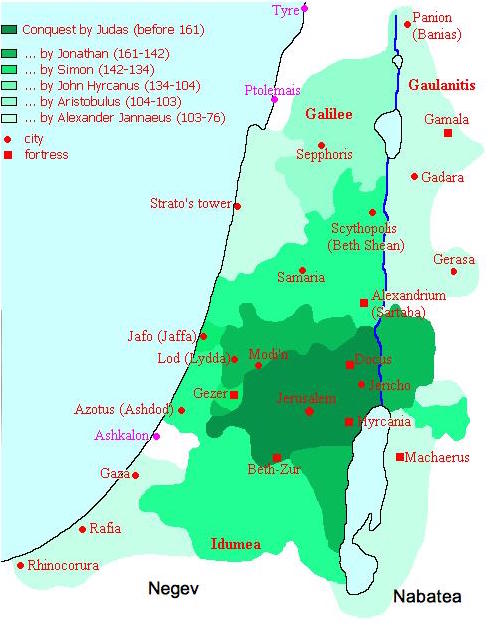 We don’t have firm evidence for the date the foundation of the tower was laid but “it was probably built by Alexander Jannaeus (103-76 BCE)” who was for his entire reign engaged in war, both foreign and internal. One of his attempted conquests, that part of the Nabatean kingdom abutting the Negev, backfired and he found his kingdom of Judea invaded in turn.
We don’t have firm evidence for the date the foundation of the tower was laid but “it was probably built by Alexander Jannaeus (103-76 BCE)” who was for his entire reign engaged in war, both foreign and internal. One of his attempted conquests, that part of the Nabatean kingdom abutting the Negev, backfired and he found his kingdom of Judea invaded in turn.
In Jericho, Jannaeus felt so insecure that he buried the existing palace beneath the spoil from a 7 m deep moat with which he surrounded it (Netzer 2002: 3-4). On top of this artificially created hill he built a much smaller ‘Fortified Palace’. The fragile political situation would have demanded the hurried erection of a watch-tower in Qumran from which warnings could be given of attempted excursions into the Buqe’ah particularly via the track that wound up the rift behind the site. It also overlooked the path to Ein Gedi (Porat 2006) and the whole of the northern end of the Dead Sea. It was not intended as a defendable fort – the track to the Buqe’ah could more easily be defended by a handful of troops judiciously placed on high ground, from where they could roll boulders and missiles down on the necessarily single file of any attackers toiling up the switch-back track. (p. 36)
So we have the context for the earlier quotation regarding Qumran being one of several sites developed by Jannaeus and being “a veritable maelstrom of activity rather than an isolated ascetic site”.
The tower at Qumran would have played a small part in the establishment of control over the lower rift valley and the Negev.
The control of water supplies, particularly in the desert, has always been a demonstration of political power. In the time of Jannaeus, the pressure on the limited available water supplies in both Jericho and Ein Gedi, for domestic use but especially for the irrigations of crops, the processing of which were so lucrative (Stacey 2006: 191-202, Porath 2005), would have encouraged the exploitation of the alternative water resources of Qumran, which must be considered an integral, though outlying, part of the Jericho estate.39 With the expansion of Jannaeus’ sphere of control east of the Jordan the strategic military importance of Qumran was reduced, but the increased security allowed the industrial activities to expand. (p. 36)
We will see in the next post the nature of those “industrial activities”.
.
Dam, aqueduct and “ritual baths”
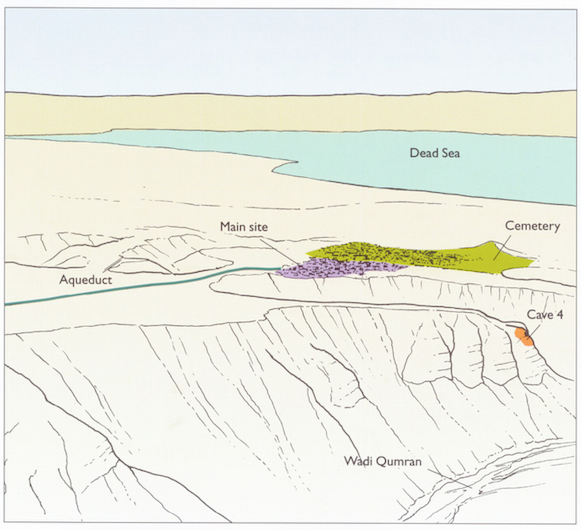
Again from BiblePlaces.com:
Requiring vast amounts of water for their daily purification rites, the Essenes had to channel the water from the wadi during the infrequent winter storms.
This dam helped to divert the water into an aqueduct which led to the site which in turn had dozens of cisterns, mikvot and pools.
That dam was not the kind of structure that a reclusive religious community was likely to construct. For it to work it needed a concrete core like other dams from the first century BCE (the time of Herod):
Roman concrete was made utilising pozzolana or volcanic ash, a raw material not found in Palestine, which would have been imported from Italy. It has been estimated that between 100 and 150 large shiploads of pozzolana had to be imported for the harbour at Caesarea alone (Oleson 2005) so it is logical to suppose that most of the few ‘concrete’ structures known in Palestine, including the Qumran dam, were constructed during the same period as the Harbour, c. 20-15 BCE. ‘These typical Roman materials are very rare in the East of the Imperium Romanum and they can only be explained by conscious and expensive importation resulting from a close relationship with Rome‘ (Lichtenburger 2009: 42, and see 50-52).23
I will address that footnote #23 in a moment.
Stacey informs us that there were “only two other dams . . . known in Second Temple Judea, both of which have been attributed to Herod.” Herod was known to have been an importer of Roman technological know-how, such as the arcaded aqueducts. The dams were constructed to feed water to aqueducts to Caesarea and Jerusalem, and feeding the aqueduct to Qumran was likewise the function of the aqueduct to Quram.
In the Encyclopedia of the Dead Sea Scrolls (and here we return to footnote #23) we read that
The aqueduct bringing water to the site is short but highly sophisticated, and required the use of Roman measuring instruments and technology.
Herod was hardly likely to have been dedicated to supporting an isolated community of devouts, so how does the article explain this unexpected piece of data?
The structure at Qumran and the meager finds unearthed there also show that the people of Qumran were not poverty-stricken. The midrashim [scroll writings] preserve the memory of . . . a group that emerged from the wealthy class in Judea (Safrai, 1979, p. 46). . . . [T]the members of the groups that broke away from Jerusalem were wealthy individuals. Those who joined the sect came primarily from the elite strata of Judean society, and when they joined the Qumran community, they brought with them considerable funds and means of production. The aforementioned ostracon discovered in Qumran in l996 attests to a propertied new member who gave over his possessions to the community. The supposition that those joining an ascetic community came from the ranks of the wealthy may be surprising. Throughout history, however, members of the elite strata have been the ones to initiate many social revolutions, from the monastic movement to the Communist movement in Europe. . . . . (232) Safrai, Z. and Eshel, H. (2000) Economic Life. Pp. 228-33 in L. Schiffman and J. VanderKam (eds.) Encyclopedia of the Dead Sea Scrolls. OUP, Oxford.
As for those ritual baths (miqva’ot), scholars attached to the Essene hypothesis concede that they are not the normal size miqva’ot and overlook a more direct or simpler explanation for them. The water supply was elevated above the Qumran structures so the simplest way of accessing water was to dig large cisterns into which water could be channeled with the assistance of gravity.
The large pools in Qumran . . . which have often been identified as miqva’ot (ritual baths) despite the fact that they ‘are considerably larger than most contemporary miqva’ot’ (Collins 2010: 189), were primarily cisterns, the pragmatic equivalent of rock hewn cisterns elsewhere but requiring far less effort to construct as they were dug into the marl. Their mistaken identification as miqva’ot is often used, in circular argumentation, to bolster the case for Qumran being a religious, sectarian settlement (Magness 2002: 158; Collins 2010: 196). (p. 18)
What, then, was the state of water supply before the time of Herod? According to Stacey’s article,
The water supply of Hasmonean Qumran was meagre, consisting only of the cisterns L110, L117 and L118, and would only have supported limited occupation of the site during the winter season, when what water there was at its freshest and most abundant. (p. 34)
The diagrams below are taken from pages 35 and 26 of Qumran Revisited; the yellow outline portrays the layout during the Hasmonean period. I have added the pointers to the three cisterns mentioned above. (I understand that rainwater was stored in underground cisterns.)
The politics of water access need consideration as much as the economics.
The control of water supplies, particularly in the desert, has always been a demonstration of political power. In the time of Jannaeus, the pressure on the limited available water supplies in both Jericho and Ein Gedi, for domestic use but especially for the irrigations of crops, the processing of which were so lucrative (Stacey 2006: 191-202, Porath 2005), would have encouraged the exploitation of the alternative water resources of Qumran, which must be considered an integral, though outlying, part of the Jericho estate.39 With the expansion of Jannaeus’ sphere of control east of the Jordan the strategic military importance of Qumran was reduced, but the increased security allowed the industrial activities to expand. (p. 36)
Likewise at a later time we can scarcely imagine Herod allowing a religious sect to maintain a monopoly control of water in such a location.
Notice a missing detail in the above model if we are indeed looking at a long-term community habitation. There are no dedicated living quarters.
There are no dedicated living quarters anywhere at Qumran in this period yet this phase lasted from c. 100 BCE until at least 31 BCE. The lack of living space and the limited water supply indicates that the site was only used seasonally for a few months in the winter.
Qumran was not the ‘”closed settlement” having … but little contact with the outside world’ (Harding 1952: 105) as envisaged by the early excavators. Although in a marginal area, for a few weeks in the winter, it played a small but important part in the regional economy being a centre for various industrial activities. (p. 37)
.
Dining hall or storeroom?
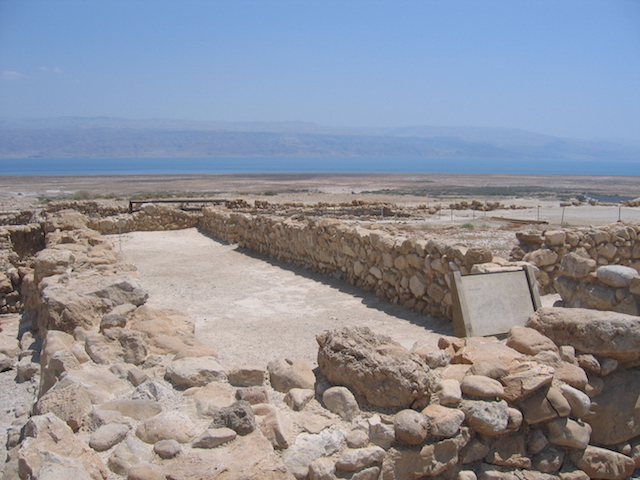
This long room was used for communal meals. Three rows of tables were apparently in place where the Qumranites ate in silence.
In the next room over, more than 1000 complete vessels were found including 708 cups, 210 plates and 108 salad bowls. All of these were serving vessels as they were never fired.
Stacey suggests otherwise:
De Vaux, influenced by the concept of Qumran as a communally-eating, sectarian settlement, extravagantly identified this room as a ‘refectory’ and ‘a place where the president of the assembly would have taken his stand’ (de Vaux 1973: 11), although evidence from Masada, already available to de Vaux before his death, shows that such long, comparatively narrow, rooms were used as storerooms (Yadin 1966: 86-105). Similar storerooms have since been found at Herodium (Netzer 1981: 21-25) and Jericho (Netzer 2001: 131-32, Plan 14). (p. 41)
The long room L77 he identified as a ‘refectory’ although the many parallels that have been excavated since indicate that it was a typical storeroom.109 . . .
.
#109 Unless the similar c. twenty ‘storerooms’ at Masada were separate dining rooms for twenty different sects! (p. 66)
.
Continued in the next post. . . .
If you enjoyed this post, please consider donating to Vridar. Thanks!

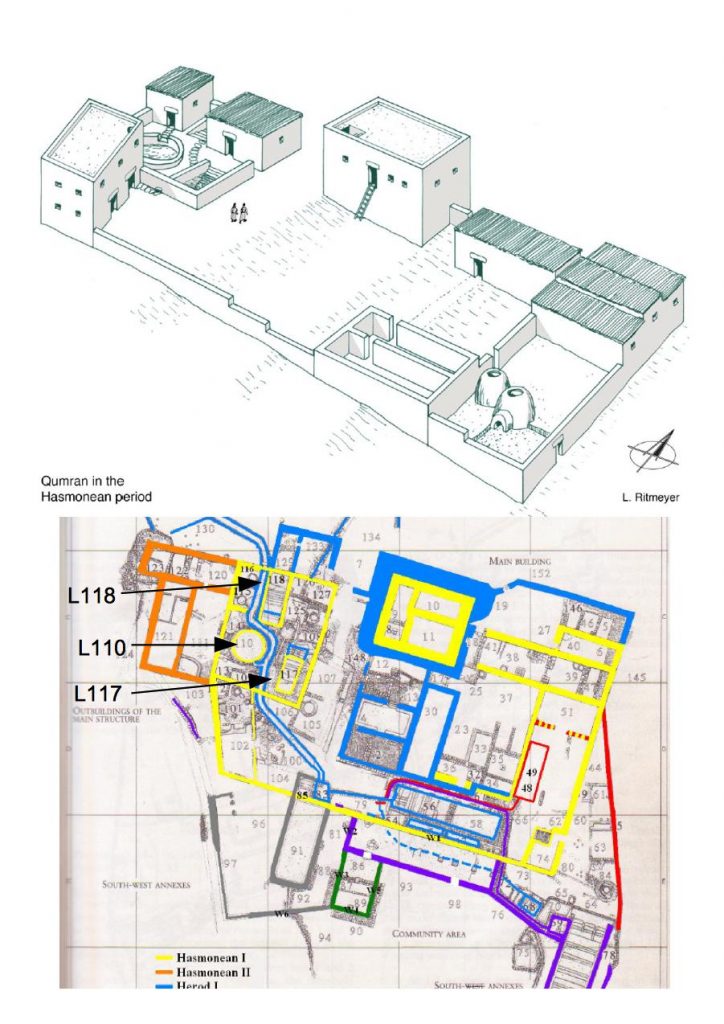
Always a good idea to run one’s theories about an archaeological site against sites with similar features. Thanks for bringing this to my attention!
This is an excellent read. I look forward to more.